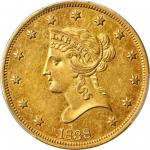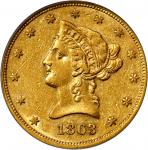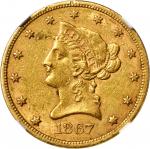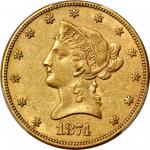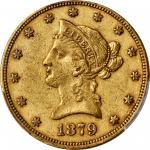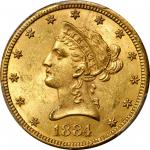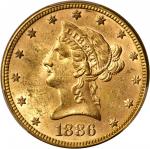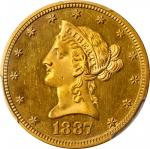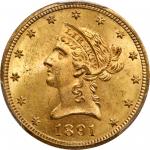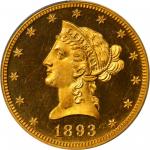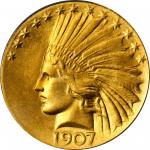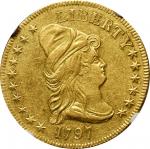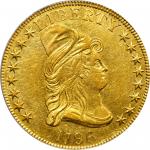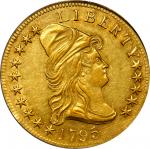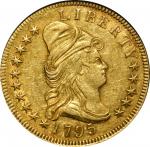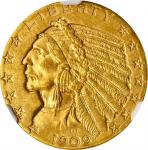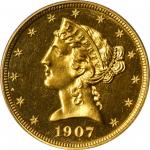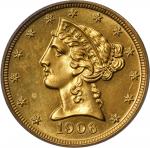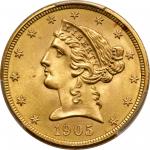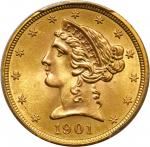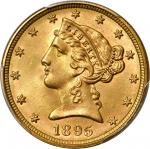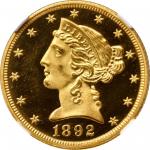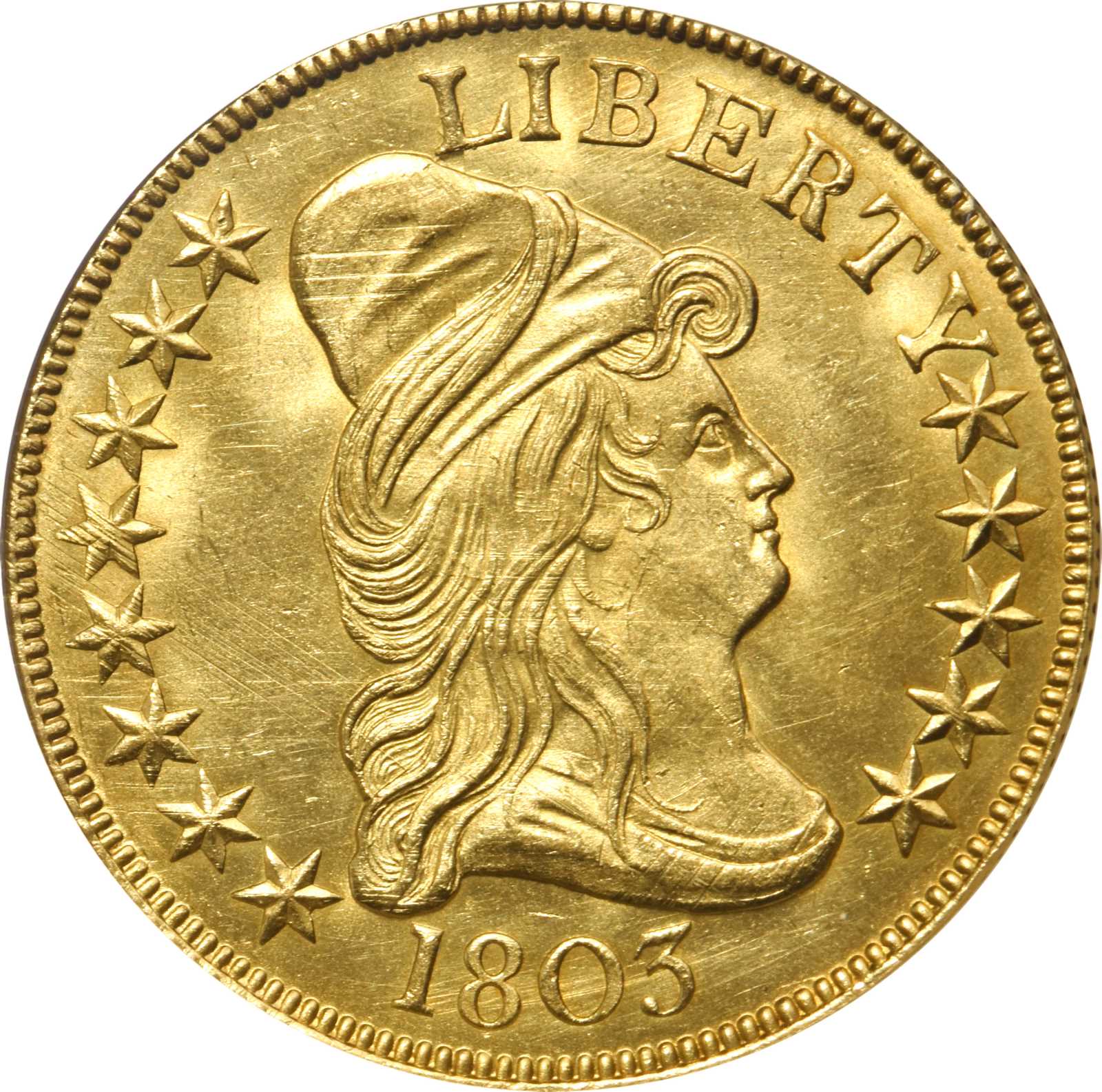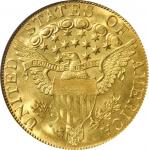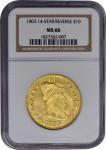1803 Capped Bust Right Eagle. BD-5, Taraszka-30. Rarity-4+. Large Reverse Stars, Extra Star. MS-66 (NGC). A truly exceptional early gold coin, perhaps the very finest example of this issue, and one of the most remarkable survivors from this entire design type. Satiny bright golden-apricot surfaces show natural pale green highlights and exceptional mint luster. The strike is above average for the issue, with even Libertys lowest hair curl well defined, and other aspects likewise bold. The pristine fields are free of marks and show only the most insignificant blemishes, and then again only under close inspection with a loupe. A single tiny nick on the bridge of Libertys nose is offered as an identifier for provenance purposes. Some vestiges of planchet adjustment are seen on the obverse, with batches crossing the truncation of the bust and cap, and another patch blending into the lower left obverse field across stars 4 and 5. When we (Bowers and Ruddy) offered this piece in 1978, it was described as "sharply struck, very lustrous, and with lovely smooth fields. Doubtless one of the finest available heraldic eagle $10 gold pieces." As accurate a description now as it was then. BD Die State g/b.
According to Walter Breen, the mintage for the 1803-dated eagle is 15,017 coins, divided into 8,979 pieces for the Small Reverse Stars <em>Guide Book</em> variety and 6,038 coins for the BD-5 Large Reverse Stars, Extra Star die pairing. Most numismatic references, including the <em>Guide Book</em>, have long accepted this figure for the 1803 eagle. The author further divides the Small Reverse Stars mintage into 4,816 coins delivered on August 19, 1803, and 4,163 coins delivered on November 19, 1803. Breen attributes the 6,038 eagles delivered from June 1 to December 11, 1804, to the BD-5 Large Reverse Stars, Extra Star variety. John Dannreuther (2006), however, provides a range of 13,850 to 20,450 eagles struck from 1803-dated dies, the higher estimate likely closer to reality since we know that the 1803 BD-6 is a backdated variety struck after the 1804 BD-1 and, hence, is not included in Breens estimate given above.
The BD-5 variety represents the fifth of six uses of this obverse die, which is the only one of the 1803-dated issue, and the only use of this reverse die. The reverse die is easily attributable due to the presence of a tiny extra star within the final cloud. This feature is fully discernible on the present example. On some coins, however, the star is faint to absent due to striking deficiencies and/or wear. On such pieces, the space between the eagles left talon and the final letter A in AMERICA confirms the Extra Star reverse and, by extension, the BD-5 attribution. On the only other Large Reverse Stars variety of the 1803 eagle, BD-6, the eagles left talon is joined to that letter.
Due to the extra star feature, the 1803 BD-5 is one of the most readily attributable and eagerly sought varieties in the entire Capped Bust Right eagle series of 1795 to 1804. Although this die marriage had been confirmed prior to that time, Harry W. Bass, Jr. appears to have been the first numismatist to notice the extra star feature on the reverse when he acquired an example in 1966. This discovery was the catalyst that launched Harry into his career of die studies of gold coins from 1796 to 1834. The extra star is much smaller than those used in the primary obverse and reverse designs, so it seems likely to some observers that it was added to the reverse intentionally by a Mint employee as a way to identify this die. This is only a theory, however, and as Dannreuther so eloquently puts it, "This is another early gold mystery that defies explanation."
With 90 to 110 coins believed extant, BD-5 ranks behind only BD-3 as the second most frequently encountered die marriage of the 1803 eagle. As a perusal of our past sales makes clear, however, the finest examples typically offered in todays market are certified AU-58. This phenomenal NGC MS-66 example is the finest of four coins in the "Significant Specimens" listing in Anthony J. Taraszkas reference <em>United States Ten Dollar Gold Eagles: 1795-1804</em>. The authors own specimen was certified MS-62 by PCGS at the time of our August 2019 sale of the Taraszka Collection, the present example also finer than any Harry Bass owned. It also ranks high in the Condition Census for the Capped Bust Right eagle series as a whole, including both the Small and Heraldic Eagles design types. The only examples certified finer than MS-65 by PCGS are the MS-66+ 1795 BD-4 from the Pogue Collection and an equally exquisite 1799 BD-10 certified MS-66. Besides the present example, NGC has certified only one other Capped Bust Right Eagle finer than MS-65 - a 1799 in MS-66. A type set along the lines of that built by the most famous collectors in the history of U.S. numismatics would be hard pressed to locate a better specimen, and the growing ranks of early gold specialists are also apt to compete vigorously for this impressive coin. Surely, no finer example from these dies could be located. From our (Bowers and Ruddys) sale of the Robert Branigan Collection, April 1978, lot 1553; our (American Numismatic Rarities) Old West & Franklinton Collections sale, August 2006, lot 1538.

